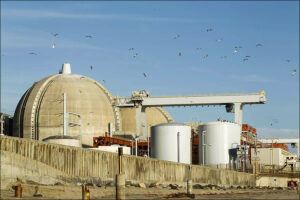
CITY HALL — Elected officials signaled their intention to stand with Southern California environmental groups calling on state regulators to conduct a full investigation into the safety concerns and repair costs of the San Onofre nuclear power plant.
The City Council last week directed staff to draft a letter in support of such an investigation on the recommendation of the Taskforce on the Environment, a council advisory group on environmental issues.
The gesture was much appreciated by environmental groups from San Clemente, a community just north of the San Onofre facility, in part because it was Santa Monica-based groups that guided their environmental efforts.
"San Clemente Green took the lead from Santa Monica," said Gary Headrick, founder of the environmental group San Clemente Green. "We weren't an anti-nuclear group, we wanted our city to be a sustainable city and used Santa Monica as a model for ours. It's interesting — now that we've learned from Santa Monica to create our own Sustainable Action Plan, it looks like Santa Monica is helping us too in taking the lead on the nuclear issue."
The power plant, also called SONGS, lies approximately 80 miles to the south of Santa Monica, and has been shut down since Jan. 31 after a leak in a steam generator tube sent radioactive vapor into the air.
According to documents released by Southern California Edison, the company that owns the plant, four steam generators were installed at San Onofre units 2 and 3 in 2010 and 2011 respectively.
In the first quarter of 2012, a heat transfer tube in Unit 3 sprung a leak, and the entire section was shut down. At the same time, Unit 2 was already offline for a planned outage after some of the heat transfer tubes showed unexpected wear.
A report by the U.S. Nuclear Regulatory Commission released in July 2012 holds faulty computer modeling to blame for the problems at SONGS.
If the reactors are out of commission for more than nine months, the CPUC is required to open an investigation to determine whether or not to refund customers for the time that the energy facility was down.
A letter from the Division of Ratepayer Advocates of the CPUC estimated the cost of running the dysfunctional plant at $54 million per month.
That's a lot of reasons to get the plant up and running before the commission has to weigh in, whether or not the facility is ready for operation, Headrick said.
"The underlying part is that Edison is highly motivated to start those generators for financial reasons, not safety reasons," Headrick said. "… What Santa Monica did was not just important in terms of what rate-payers will be expected to pay or not, but if we can avoid starting reactors that are unsafe."
Residents of San Clemente have been made uncomfortably aware of the city's proximity to the plant since the March 2011 disaster at the Fukushima Daiichi nuclear power plant in Japan.
An earthquake and tsunami caused safety systems at the plant to fail, causing a release of radioactive materials on the island.
San Onofre is also near a fault line, Headrick said.
"Before Fukushima happened, it was in the background," Headrick said. "We knew it was there, but there were not a lot of urgent problems that brought it to the surface. Since Fukushima, the fears we had used to be hypothetical, but now they're based in reality."
According to the Natural Resources Defense Council, Santa Monica lies just outside of the 50-mile contamination zone outlined by the federal government for nuclear disasters.
That 50-mile figure is an "arbitrary number," Headrick said.
After the Fukushima Daiichi nuclear power plant blew, scientists found "hot spots" of radioactive material over 150 miles from the disaster site, according to Nature, an international weekly science journal.
SCE has stated that it will not restart the two SONGS units until the utility and nuclear commission have declared that it is safe to do so, according to a release put out by the company on Aug. 14.
"We are currently focused on our planning for the repairs and safe operation of Unit 2, which we will submit to the Nuclear Regulatory Commission as soon as the plans are complete," said Pete Dietrich, senior vice president and chief nuclear officer for the utility company.
ashley@www.smdp.com









